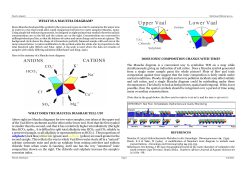
Ionic Compounds Worksheet 1 Directions: Write the formula unit for
Ionic Compounds Worksheet 1 Directions: Write the formula unit for the given ionic compound if the name is given. If the formula unit is provided write the name of the ionic compound 1. Lithium oxide 21. CaO 2. Calcium fluoride 22. PI3 3. Aluminum sulfide 23. BaF2 4. Potassium nitride 24. MnO 5. Barium oxide 25. SnO2 6. Copper (I) oxide 26. CuF 7. Tin (IV) sulfide 27. MgS 8. Magnesium iodide 28. AlN 9. Iron (III) bromide 29. CaF2 10. Chromium (II) selenide 30. K2S 11. Tin (II) fluoride 31. SnO 12. Magnesium oxide 32. Ba3N2 13. Lead (IV) sulfide 33. K2S 14. Manganese (III) bromide 34. CoN 15. Copper (II) sulfide 35. PbS2 16. Chromium (III) iodide 36. RbF 17. Iron (II) nitride 37. NaCl 18. Rubidium phosphide 38. SnO 19. Mercury (II) nitride 39. CaS 20. Manganese (IV) nitride 40. Li2O 41. Why do metals lose electrons and nonmetals gain electrons? 42. What is the charge of an ionic compound? 43. List 3 properties of ionic compounds Not an Ionic Compound… Why? 1. Circle the atom of the element that has a larger atomic radius Magnesium or Fluorine 2. Circle the atom of the element that requires more energy to lose electrons (greater ionization energy) Magnesium or Fluorine 3. Show how Magnesium and Fluorine chemically combine to form Magnesium fluoride using Lewis dot structures 4. Write the electron configuration for Mg _____________________________________________________ Mg2+____________________________________________________ F_______________________________________________________ F-_______________________________________________________ 1. Circle the atom of the element that has a larger atomic radius Aluminum or Sulfur 2. Circle the atom of the element that requires very little energy to lose electrons (small ionization energy) Aluminum or Sulfur 3. Show how Aluminum and Sulfur chemically combine to form Aluminum sulfide using Lewis dot structures 4. Write the electron configuration for Al _____________________________________________________ Al3+____________________________________________________ S_______________________________________________________ S2-______________________________________________________ 5. Why do transition metals, when becoming ions, need a roman numeral after the name when Group 1,2 and 3 metals do not when becoming ions?
© Copyright 2025





















